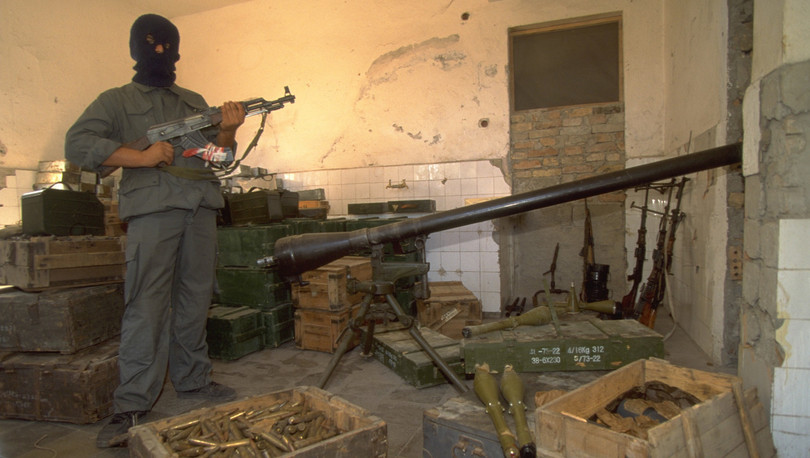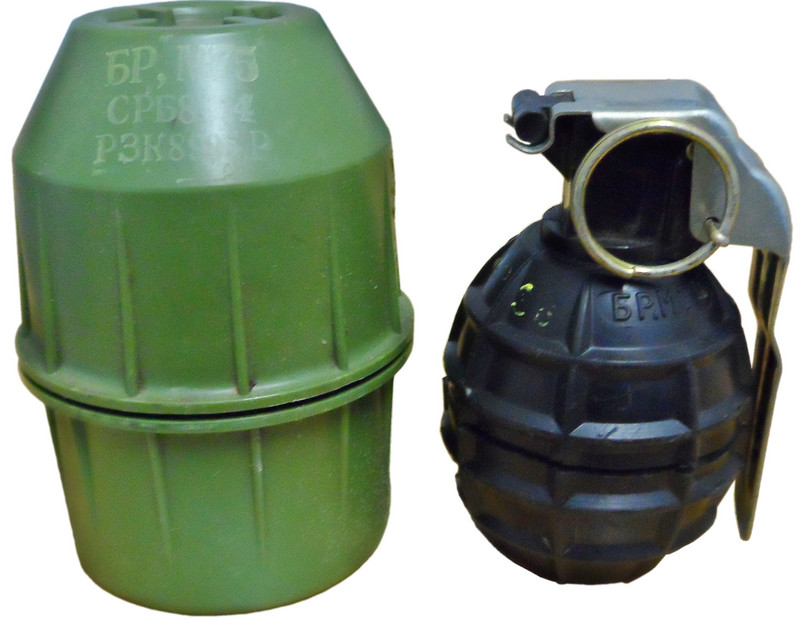Illicit weapons in the Western Balkans: a threat to Europe

Stockpiles of firearms are seized in Vlora, Albania, August 1997.
© Alain Nogues/Sygma/via Getty Images
On 30 September 2020, almost 9 000 law-enforcement personnel from 34 countries took part in a joint operation against organized crime in South Eastern Europe. 1 The four-day operation, supported by Europol, aimed to tackle illegal immigration and trafficking; 166 people were arrested on charges related to trafficking in weapons, people and drugs. More than 51 weapons of different types were seized.
Smuggling of weapons from the Balkans has been a concern since the 1990s and, evidently, the problem has not abated: ‘Millions of light weapons circulating in the Western Balkans pose a great threat to European security,’ said French Foreign Minister Jean-Yves Le Drian in a joint press conference with his German counterpart, Heiko Maas, in December 2018.2 Police in Sweden, concerned by growing gang violence, have recorded a marked increase in the use of pistols, revolvers, automatic weapons and even grenades smuggled from the Western Balkans. And the ongoing war between Montenegrin clans has been characterized by violence using a range of weapon types, including automatic weapons and plastic explosives. How serious is the supply of illicit weapons in the Western Balkans? And what are the risks to the region and beyond?
South Eastern Europe is awash with weapons left over from the wars in the former Yugoslavia, including those imported during the 1990s, weapons left behind by the Yugoslav National Army, and those used in Kosovo in 1999 and North Macedonia in 2001. Weapons were also plundered from armouries during civil unrest in Albania in 1997. According to conservative estimates from the UN and Europol, as well as from regional experts, there are more than 3 million illicit weapons in the six countries of the Western Balkans plus Croatia.3 That is an average of 30 weapons (legal and illicit firearms) per 100 inhabitants.4
The Geneva-based Small Arms Survey shows that in 2017, Montenegro and Serbia, each with 39.1 weapons per 100 residents, rank third worldwide and first in Europe in civilian-held firearms. Other Western Balkan countries are also high on the list: Bosnia and Herzegovina rank fifth in Europe and ninth worldwide (31.2 per 100 residents); North Macedonia is seventh in Europe and 13th worldwide with 29.8 per 100 residents; Kosovo ranks 11th in Europe with 23.9 per 100 residents and 16th in the world.5
Almost all types of small arms and military-grade weapons can be procured in the Western Balkans and Croatia, even anti-tank weapons, explosives, mortars, hand-held rocket launchers and light anti-aircraft guns.

| United States | 120.5 | Iceland | 31.7 | Sweden | 23.1 |
| Yemen | 52.8 | Bosnia and Herzegovina | 31.2 | Pakistan | 22.3 |
| Montenegro | 39.1 | Austria | 30.0 | Portugal | 21.3 |
| Serbia | 39.1 | Macedonia | 29.8 | France | 19.6 |
| Canada | 34.7 | Norway | 28.8 | Germany | 19.6 |
| Uruguay | 34.7 | Malta | 28.3 | Iraq | 19.6 |
| Cyprus | 34.0 | Switzerland | 27.6 | Luxembourg | 18.9 |
| Finland | 32.4 | New Zealand |
Figure 1 Estimated rate of civilian firearms holdings in the 25 top-ranked countries and territories, 2017 (firearms per 100 residents).
Aaron Karp, Estimating global civilian-held firearms numbers, Small Arms Survey, June 2018, www.smallarmssurvey.org/fileadmin/docs/T-Briefing-Papers/SAS-BP-Civilian-Firearms-Numbers.pdf.

| Country | Estimated amount of illicit weapons |
|---|---|
| Albania | 210 0006 |
| Bosnia and Herzegovina | 750 0007 |
| Croatia | 600 0008 |
| Kosovo* | 200 0009 |
| Montenegro | 170 00010 |
| North Macedonia | 500 000 |
| Serbia | 1 000 00011 |
Figure 2 Estimated number of illicit weapons by country, Balkans region.
*Note: The designation of Kosovo is without prejudice to positions on status and is in line with UN Security Council Resolution 1244 and the International Court of Justice Opinion on the Kosovo declaration of independence.
Source: Small Arms Survey, Civilian firearms holdings, 2017, http://www.smallarmssurvey.org/fileadmin/docs/Weapons_and_Markets/Tools/Firearms_holdings/SAS-BP-Civilian-held-firearms-annexe.pdf
Smuggling, use and cost of illicit weapons
Most of these weapons are hidden in people’s homes, on the black market or in the possession of criminals. Since 2015, a spate of assassinations related to a war between criminal groups in Montenegro has killed dozens in incidents involving automatic weapons or plastic explosives.
The average price of weapons in the Western Balkan countries ranges from €10 for a hand grenade to €150–400 for a pistol.12 Semi-automatic rifles cost between €150 and 300, while automatic rifles are around €200 to 400.

An M-75 type hand grenade and canister.
© WikiCommons
Explosives from the Western Balkans can also be found on the black market: plastic C4 explosive costs between €1 500 and 4 000 per kilogramme. Until 1991, only four countries in the world, including the former Yugoslavia, produced this type of explosive. It was manufactured in a military factory in Berane (now Montenegro). Plastic explosives are widely used by criminals in Montenegro and Serbia, particularly for blowing up vehicles – on 13 September 2020, this type of explosive was allegedly used to blow up a car in Belgrade.
When it comes to smuggling illicit weapons, criminals from the Western Balkans are well connected to arms traffickers from Croatia and Slovenia, where there have been several major weapons seizures.13 Illicit weapons are smuggled by organized-crime networks throughout Europe, usually involving groups that are engaged in the illicit trafficking of other goods (such as drugs). In some cases, weapons have been traded for drugs. Weapons from the Western Balkans have been found in Austria, France, Germany, Italy, the Netherlands, Spain, Sweden and the UK.14 Some of these weapons are used by criminal groups; others end up in the hands of terrorists.
The UK’s National Crime Agency has warned that the number of illicit weapons in the UK will continue to increase; weapons from the Western Balkans are at the forefront of the illicit market.15 The agency fears that some of the illicit weapons from the Western Balkans might be used in terrorist attacks.
In Sweden, the number of murders linked to organized-crime groups that use illicit weapons from the Western Balkans is on the rise.16 The buyers of illicit weapons are members of organized criminal groups and gangs. In this normally peaceful country, there were 320 incidents and 42 deaths in 2019 due to armed violence,17 including a shocking number of cases involving M-75 hand grenades produced in the former Yugoslavia. These can be purchased for as little as 100 crowns (€9.60).18
According to French police, terrorists involved in the attacks in Paris in January and November 2015, including the massacre at the Bataclan concert hall, used illegal weapons from the Western Balkans.19 There are also reports of weapons produced in the Balkans ending up in war zones like Syria.20
Motorcycle gangs are also involved in the illicit trafficking of weapons from the Western Balkans. Contacts that previously trafficked drugs and people are now being used to smuggle weapons. The notorious Ćulum brothers, who were active in the United Tribune motorcycle gang, are apparently operating out of Bosnia and Herzegovina after being banned from Germany as a threat to national security.21 They have allegedly been involved in drug and arms trafficking in Germany, Austria and Switzerland.22 Other groups, like the Bandidos based in Göteborg, are said to be expanding their contacts in the Balkans.23 The most popular route for trafficking weapons to Western Europe is the Balkan Route.
The EU has recognized the problem of illicit weapons in the Western Balkans and is involved in joint programmes with regional governments. In 2017, France and Germany launched an initiative to suppress firearms smuggling in the Western Balkans, with an action plan until 2024.24 As part of the Berlin Process, a roadmap for a sustainable solution to the illegal possession, misuse and trafficking of small arms and light weapons, and ammunition in the region was adopted at the Western Balkans summit in London in July 2018.25 Given the number of weapons in circulation, urgent action is needed to reduce the risk of these weapons getting into the hands of criminals and terrorists.
Notes
-
Europol, 166 arrested in international crackdown against crime in Southeast Europe, 30 September 2020, https://www.europol.europa.eu/newsroom/news/166-arrested-in-international-crackdown-against-crime-in-southeast-europe. ↩
-
European Western Balkans, French Foreign Minister: Small arms from the Western Balkans are a threat to European security, 11 December 2018, www.europeanwesternbalkans.com/2018/12/11/french-foreign-minister-small-arms-western-balkans-threat-european-security/. ↩
-
Ted Leggett, Crime and its impact on the Balkans and affected countries, UNODC, March 2008, https://www.unodc.org/documents/data-and-analysis/Balkan_study.pdf. ↩
-
Aaron Karp, Estimating global civilian-held firearms numbers, Small Arms Survey briefing paper, June 2018, www.smallarmssurvey.org/fileadmin/docs/T-Briefing-Papers/SAS-BP-Civilian-Firearms-Numbers.pdf. ↩
-
Ibid. ↩
-
For this figure, see https://www.politico.eu/article/the-european-nation-with-a-deadlier-gun-culture-than-the-us-albania/. ↩
-
750 000 weapons in BiH, https://www.ba.undp.org/content/bosnia_and_herzegovina/en/home/presscenter/articles/2015/03/07/arms-control-exchange-bosnia-and-herzegovina-and-argentina.html#:~:text=Small%20arms%20are%20also%20problematic,1990s%2C%20are%20still%20in%20circulation. ↩
-
See https://zadarski.slobodnadalmacija.hr/zadar/forum/vec-imamo-500-000-komada-ilegalnog-naoruzanja-a-sada-ce-se-taj-broj-i-povecati-461630. ↩
-
The UN Development Programme states there are 260 000 weapons; see https://www.undp.org/content/dam/kosovo/docs/KSSP/KSSP%20Brochure_Final%20ENG%20sz.pdf. ↩
-
Authorities state there are 900 000; see https://www.rs.undp.org/content/serbia/en/home/presscenter/articles/2016/07/14/there-is-a-clear-correlation-between-illicit-firearms-and-violence.html. ↩
-
Small Arms Survey report 141 464, http://www.smallarmssurvey.org/fileadmin/docs/Weapons_and_Markets/Tools/Firearms_holdings/SAS-BP-Civilian-held-firearms-annexe.pdf. ↩
-
Information on the cost of different types of weapons is based on reliable data from criminal markets, as well as from police and court documents. ↩
-
Europol, Police raids addresses across Croatia to break arms trafficking network, 20 June 2018, www.europol.europa.eu/newsroom/news/police-raids-addresses-across-croatia-to-break-arms-trafficking-network. ↩
-
Europol, Illicit firearms trafficking, www.europol.europa.eu/crime-areas-and-trends/crime-areas/illicit-firearms-trafficking. ↩
-
Charles Hymas, Gangs buy blank-firing guns online before importing them to UK amid rise in firearms to enforce drugs, The Telegraph, 14 April 2020, www.telegraph.co.uk/politics/2020/04/14/gangs-buy-blank-firing-guns-online-importing-uk-amid-rise-firearms. ↩
-
Lee Roden, Why Swedish gangs use hand grenades (and what the country is doing about it), The Local SE, 28 February 2018, www.thelocal.se/20180228/why-sweden-is-battling-hand-grenades-and-illegal-weapons. ↩
-
Paulina Neuding, Violent crime in Sweden is soaring. When will politicians act?, The Spectator, 29 December 2018, www.spectator.co.uk/article/violent-crime-in-sweden-is-soaring-when-will-politicians-act-; see also: Sweden’s big cities see fall in number of shootings, The Local SE, 7 January 2020, www.thelocal.se/20200107/fewer-shootings-in-swedens-big-cities-in-2019. ↩
-
Karis Hustad, Sweden has a problem with hand grenades and here’s why, Euronews, 11 April 2018, www.euronews.com/2018/04/10/sweden-has-a-problem-with-hand-grenades-and-here-s-why. In ongoing research, an inter-institutional team of criminologists and researchers counted 78 cases of hand grenade explosions between 2010 and 2017, with half of those cases occurring in 2016. See Kriminologiska funderingar, Förtydligande om internationell jämförelse av handgranatsdetonationer, 11 September 2017, www.mgerell.blogspot.com/2017/09/fortydligande-om-internationell.html. ↩
-
Jasmina Rose, Islamski teroristi opskrbljuju se oružjem s Balkana, Deutsche Welle, 4 February 2020, https://www.dw.com/hr/islamski-teroristi-opskrbljuju-se-oružjem-s-balkana/a-52244446. ↩
-
L. T., Trogodišnje terensko istraživanje: Hrvatske rakete u rukama boraca Islamske države, Novi list, 15 December 2017, www.novilist.hr/Vijesti/Hrvatska/Trogodisnje-terensko-istrazivanje-Hrvatske-rakete-u-rukama-boraca-Islamske-drzave/. ↩
-
Član moto bande: Postali smo prejaki pa su hteli da nas sklone!, Kurir, 7 January 2014, https://www.kurir.rs/planeta/1168173/clan-moto-bande-postali-smo-prejaki-pa-su-hteli-da-nas-sklone. ↩
-
Višnja Kragić Mahmutović, Na čelu opasne bande: Braća Ćulum su državna opasnost, 24 sata, 24 April 2019, www.24sata.hr/news/na-celu-opasne-bande-braca-culum-su-drzavna-opasnost-626082. ↩
-
Claes Petersson and Daniel Olsson, De leder MC-gängen där du bor – här är listan, 28 December 2016, Expressen, www.expressen.se/nyheter/de-leder-mc-gangen-dar-du-bor—har-ar-listan/. ↩
-
Council of the European Union, Council decision (CFSP) 2019/2111 in support of SEESAC disarmament and arms control activities in South-East Europe reducing the threat of illicit small arms and light weapons and their ammunition, 10 December 2019, www.eur-lex.europa.eu/legal-content/EN/TXT/PDF/?uri=CELEX:32019D2111&from=EN. ↩
-
Roadmap for a sustainable solution to the illegal possession, misuse and trafficking of Small Arms and Light Weapons (SALW) and their ammunition in the Western Balkans by 2024, SEESAC, 27 September 2019, www.seesac.org/f/docs/publications-salw-control-roadmap/Regional-Roadmap-for-a-sustainable-solution-to-the.pdf. ↩
